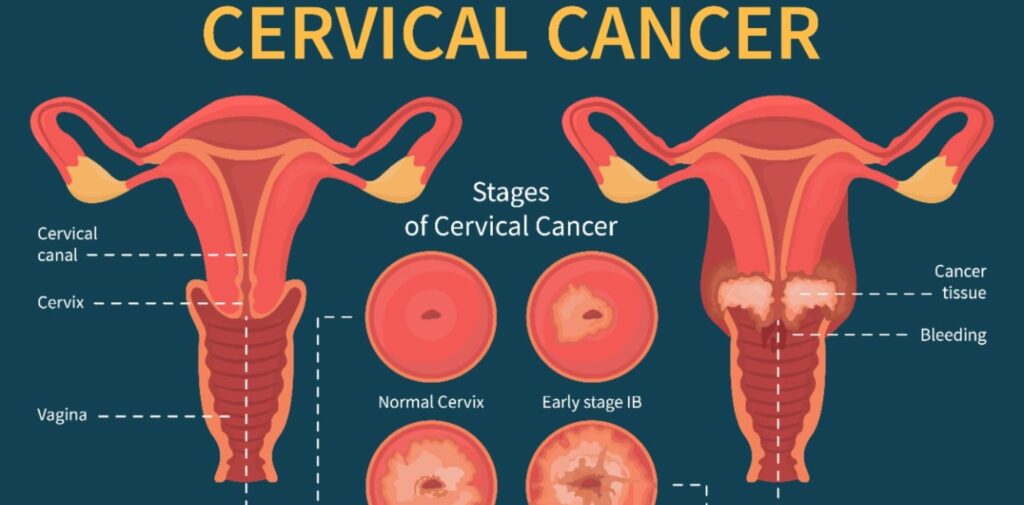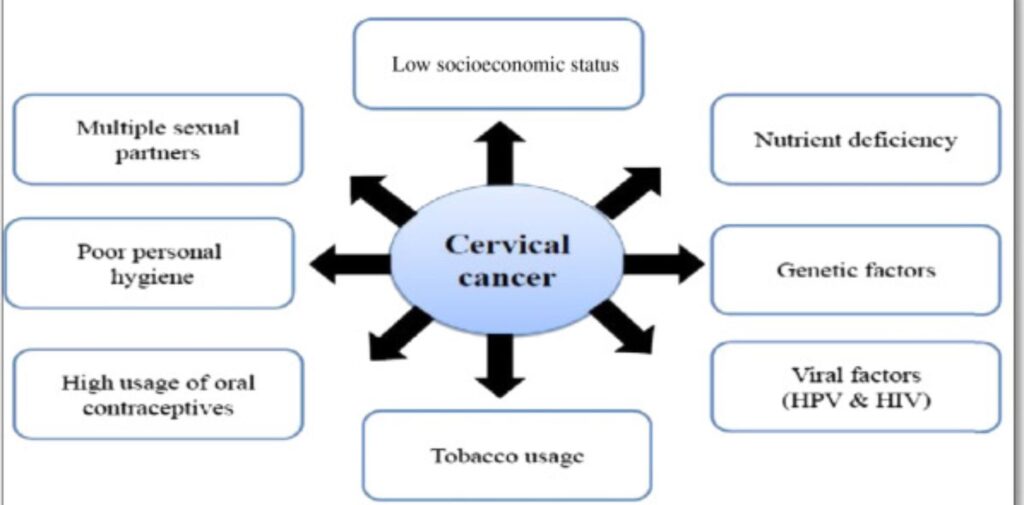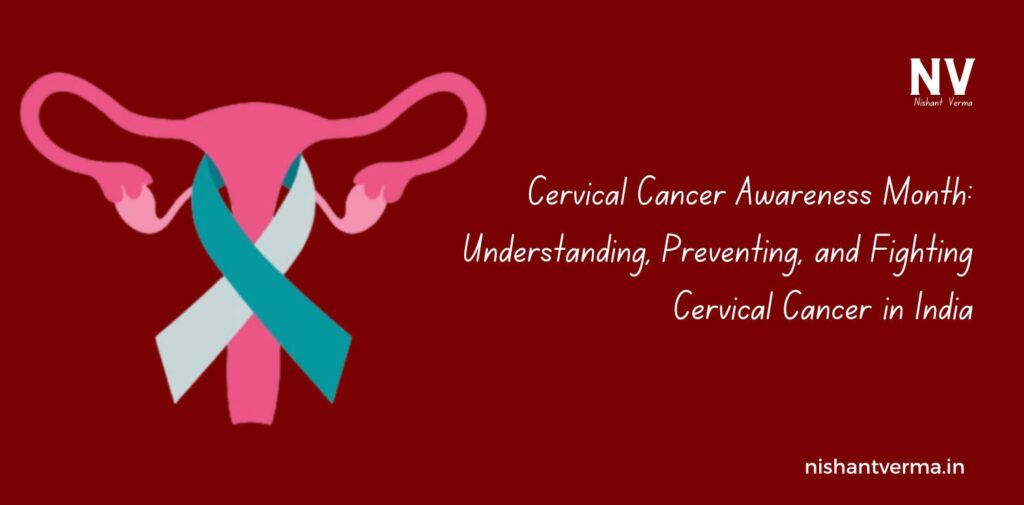January is recognized as Cervical Cancer Awareness Month globally. This is an important time to raise awareness about cervical cancer, a type of cancer that affects the cervix, the lower part of the uterus (womb), and educate people about its prevention and early detection. In India, where cervical cancer is one of the leading causes of cancer-related deaths among women, it is crucial to spread knowledge about how we can prevent it, detect it early, and ultimately save lives.
What is Cervical Cancer ?
Cervical cancer starts in the cervix, the narrow part of the uterus that connects to the vagina. It usually develops slowly over several years and is often caused by a persistent infection with certain types of the Human Papillomavirus (HPV), a very common virus that is transmitted through sexual contact. Most women who have HPV do not develop cervical cancer, but the virus can lead to changes in the cells of the cervix, which can turn into cancer if not treated.
HPV infection is the primary cause of cervical cancer, but not every HPV infection leads to cancer. Many infections clear up on their own without causing any harm. However, if the infection persists and is not detected or treated, it can lead to cancer over time. The good news is that cervical cancer is preventable through vaccines, regular screening, and early treatment.

Importance of Awareness in India
Cervical cancer is the second most common cancer among women in India after breast cancer. Every year, India reports more than 60,000 cases of cervical cancer, and more than 30,000 women die from it. The risk is especially high in rural areas due to a lack of awareness, inadequate healthcare services, and low rates of screening.
Most women diagnosed with cancer are in their 30s and 40s, making it critical for women to understand the risks and take preventive measures. However, despite its high prevalence, cervical cancer is largely preventable and treatable when caught early. Awareness and regular check-ups can make a huge difference in saving lives.
Risk Factors for Cervical Cancer
Several factors can increase the risk of cervical cancer. These include:
- HPV Infection: As mentioned, the most common cause of cancer is infection with high-risk strains of HPV. These strains are often transmitted through sexual activity.
- Early Sexual Activity: Women who begin having sex at a young age or have multiple sexual partners are at higher risk of HPV infection.
- Weak Immune System: Women with a weakened immune system, such as those with HIV/AIDS, have a higher risk of developing cervical cancer.
- Tobacco Use: Smoking is a significant risk factor as it weakens the immune system and makes the cervix more vulnerable to infection by HPV.
- Long-Term Use of Birth Control Pills: Women who have used birth control pills for five or more years may be at increased risk.
- Family History: A family history of cervical cancer can increase a woman’s risk.
- Not Getting Regular Screenings: Women who don’t get regular screenings like Pap smears or HPV tests are at greater risk of undetected cancer.

Preventing Cervical Cancer
- HPV Vaccination: One of the most effective ways to prevent cancer is to get vaccinated against HPV. The HPV vaccine is safe and can protect against the strains of HPV that are most likely to cause cervical cancer. The vaccine is recommended for girls and boys aged 9 to 14 years but can be given up to the age of 26. In India, the vaccine is becoming more accessible, and many health organizations recommend vaccinating girls before they become sexually active. Vaccination can reduce the chances of developing cancer later in life.
- Regular Screening: Early detection through regular screening is key to preventing cervical cancer. The Pap smear test (or Pap test) is a simple procedure in which a doctor collects cells from the cervix to check for abnormal changes. If any changes are found, further tests and treatment can be done before cancer develops. Women aged 21 to 65 years are recommended to get a Pap test every 3 years. The HPV test, which checks for the presence of high-risk HPV, is another important screening tool. Women aged 30 years and above are recommended to get both the Pap test and the HPV test every 5 years.
- Safe Sexual Practices: Practicing safe sex by using condoms can reduce the risk of HPV infection. Limiting the number of sexual partners also lowers the risk.
- Avoid Smoking: Smoking weakens the immune system and increases the risk of HPV infections. Quitting smoking is beneficial for overall health and can reduce the risk of cervical cancer.
- Healthy Diet and Regular Exercise: A healthy lifestyle that includes a balanced diet rich in fruits and vegetables, as well as regular exercise, can help maintain a strong immune system and lower the risk of cancer.
Signs and Symptoms of Cervical Cancer
Cervical cancer often does not show symptoms in its early stages. This is why regular screenings are so important. However, as the disease progresses, some common symptoms may include:
- Abnormal vaginal bleeding (between periods, after sex, or after menopause)
- Unusual vaginal discharge (which may be watery, bloody, or foul-smelling)
- Pain during sexual intercourse
- Pelvic pain or back pain
If you experience any of these symptoms, it is important to see a doctor for further evaluation.

Early Detection and Treatment
The good news is that cervical cancer, when detected early, can be treated successfully. Treatments may include surgery, radiation therapy, chemotherapy, or a combination of these. If caught in its earliest stages, cancer can often be cured with a simple surgical procedure to remove the affected tissue.
In India, it is essential that women have access to screening and early treatment. However, many women, especially in rural areas, face barriers to accessing healthcare, such as lack of awareness, cultural stigma, and inadequate medical facilities. That’s why Cervical Cancer Awareness Month is crucial for spreading information and encouraging women to take control of their health.
Conclusion
Cervical cancer is preventable and treatable. With the right knowledge, vaccines, regular screenings, and lifestyle changes, women in India can reduce their risk of cancer and live healthier lives. January, Cervical Cancer Awareness Month, is an excellent time for everyone to come together to raise awareness and encourage women to take proactive steps toward preventing this deadly disease.
By talking openly about cancer, supporting vaccination programs, and making screening accessible, we can reduce the burden of cancer in India and save thousands of lives.




